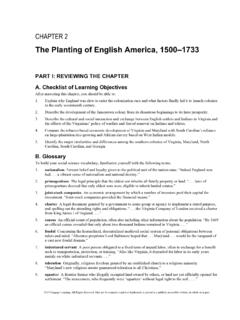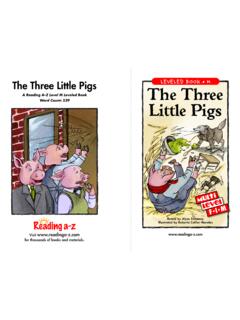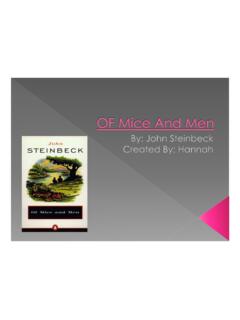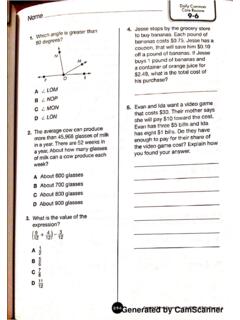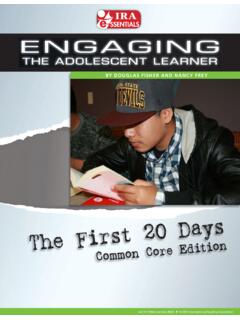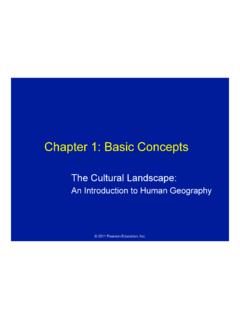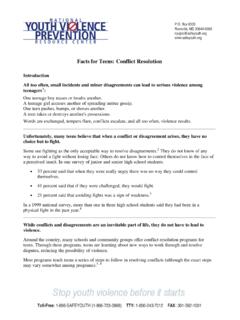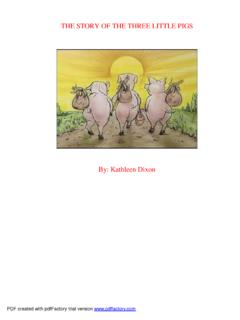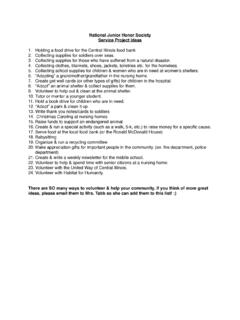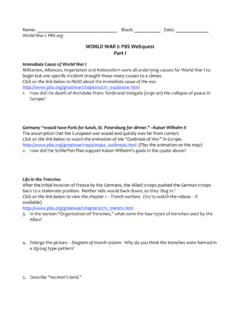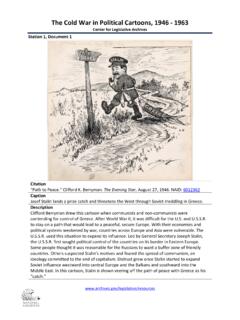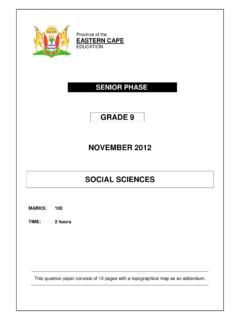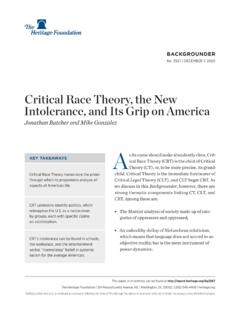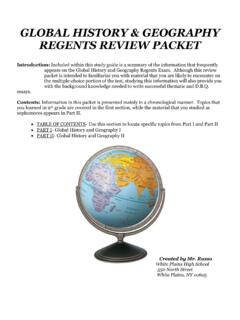Transcription of Totalitarianism - Springfield Public Schools
1 874 Chapter 30 MAIN IDEAWHY IT MATTERS NOWTERMS & NAMES2 TotalitarianismCASESTUDY:Stalinist RussiaSETTING THE STAGES talin, Lenin s successor, dramatically transformed thegovernment of the Soviet Union. Stalin was determined that the Soviet Unionshould find its place both politically and economically among the most powerfulof nations in the world. Using tactics designed to rid himself of opposition, Stalinworked to establish total control of all aspects of life in the Soviet Union. He con-trolled not only the government, but also the economy and many aspects of citi-zens private Government of Total ControlThe term totalitarianismdescribes a government that takes total, centralized,state control over every aspect of Public and private life. Totalitarian leadersappear to provide a sense of security and to give a direction for the future. In the20th century, the widespread use of mass communication made it possible toreach into all aspects of citizens lives.
2 A dynamic leader who can build support for his policies and justify hisactions heads most totalitarian governments. Often the leader utilizes secretpolice to crush opposition and create a sense of fear among the people. No oneis exempt from suspicion or accusations that he or she is an enemy of the challenges the highest values prized by Western democra-cies reason, freedom, human dignity, and the worth of the individual. As thechart on the next page shows, all totalitarian states share basic dominate an entire nation, totalitarian leaders devised methods of controland persuasion. These included the use of terror, indoctrination, propaganda,censorship, and religious or ethnic TerrorDictators of totalitarian states use terror and violence to force obe-dience and to crush opposition. Normally, the police are expected to respond tocriminal activity and protect the citizens. In a totalitarian state, the police serveto enforce the central government s policies.
3 They may do this by spying on thecitizens or by intimidating them. Sometimes they use brutal force and even mur-der to achieve their states rely on indoctrination instruction in the gov-ernment s beliefs to mold people s minds. Control of education is absolutelyessential to glorify the leader and his policies and to convince all citizens that theirPOWER AND AUTHORITYA fterLenin died, Stalin seized powerand transformed the SovietUnion into a totalitarian recent dictators have usedStalin s tactics for seizing totalcontrol over individuals and thestate. Totalitarianism Great Purge commandeconomy Five-Year Plan collective farmCategorizing Create achart listing examples of methods of controlusedin the Soviet NOTESM ethods of is a form of government in which the national governmenttakes control of all aspects of both Public and private life. Thus, totalitarianismseeks to erase the line between government and society. It has an ideology,or set of beliefs, that all citizens are expected to approve.
4 It is often led by adynamic leader and a single political party. Mass communication technology helps a totalitarian government spread itsaims and support its policies. Also, surveillance technology makes it possibleto keep track of the activities of many people. Finally, violence, such as policeterror, discourages those who disagree with the goals of the SynthesizingHow does a totalitarianstate attempt to make citizens obeyits rules?See Skillbuilder Handbook, page HypothesizingHow would your lifechange if you lived in a totalitarianstate?Totalitarian leaders in the 20thcentury Adolf Hitler (Germany)1933 1945 Benito Mussolini (Italy)1925 1943 joseph Stalin (SovietUnion) 1929 1953 Kim IL Sung (North Korea)1948 1994 Saddam Hussein (Iraq)1979 2003 State Terror The two most infamousexamples of state terror inthe 20th century were inNazi Germany and StalinistRussia. An 20million people were killedin Nazi Germany. An estimated 8 20 millionpeople were killed inStalinist Today There are manyauthoritarian regimes in theworld, but there are veryfew actual totalitariangovernments.
5 In 2000, onemonitoring agencyidentified five totalitarianregimes Afghanistan, Cuba,North Korea, Laos, LINKSFor more on Totalitarianism , go to Control of Society business labor housing education religion the arts personal life youth groups Dynamic Leader unites people symbolizes government encourages popular support through force of will Ideology sets goals of the state glorifies aims of the state justifies government actions Methods of Enforcement police terror indoctrination censorship persecution Modern Technology mass communication to spread propaganda advanced military weapons Dictatorship and One-Party Rule exercises absolute authority dominates the government State Control of Individuals demands loyalty denies basic liberties expects personal sacrifice for the good of the stateKey Traits of TotalitarianismFear of TotalitarianismGeorge Orwell illustrated the horrors of a totalitarian government in his novel, 1984.
6 The novel depicts a world in which personal freedom and privacy have vanished. It is a world made possible through modern technology. Even citizens homes have television cameras that constantly survey their 30unconditional loyalty and support arerequired. Indoctrination begins with veryyoung children, is encouraged by youthgroups, and is strongly enforced by and CensorshipTotalitarianstates spread propaganda, biased or incom-plete information used to sway people toaccept certain beliefs or actions. Control ofall mass media allows this to happen. Nopublication, film, art, or music is allowed toexist without the permission of the are surrounded with false informa-tion that appears to be true. Suggesting thatthe information is incorrect is consideredan act of treason and severely who dissent must retract theirwork or they are imprisoned or or Ethnic PersecutionTotali-tarian leaders often create enemies of the state to blame for things that go these enemies are members of religious or ethnic groups.
7 Often thesegroups are easily identified and are subjected to campaigns of terror and may be forced to live in certain areas or are subjected to rules that apply onlyto them. CASE STUDY:Stalinist RussiaStalin Builds a Totalitarian StateStalin aimed to create a perfect Communist state in Russia. To realize his vision,Stalin planned to transform the Soviet Union into a totalitarian state. He beganbuilding his totalitarian state by destroying his enemies real and StateStalin built a police state to maintain his power. Stalin s secret policeused tanks and armored cars to stop riots. They monitored telephone lines, readmail, and planted informers everywhere. Even children told authorities about dis-loyal remarks they heard at home. Every family came to fear the knock on the doorin the early morning hours, which usually meant the arrest of a family member. Thesecret police arrested and executed millions of so-called traitors. In 1934, Stalin turned against members of the Communist Party.
8 In 1937, helaunched the Great Purge, a campaign of terror directed at eliminating anyone whothreatened his power. Thousands of old Bolsheviks who helped stage the Revolutionin 1917 stood trial. They were executed or sent to labor camps for crimes againstthe Soviet state. When the Great Purge ended in 1938, Stalin had gained total con-trol of the Soviet government and the Communist Party. Historians estimate thatduring this time he was responsible for 8 million to 13 million deaths. Russian Propaganda and CensorshipStalin s government controlled all news-papers, motion pictures, radio, and other sources of information. Many Soviet writ-ers, composers, and other artists also fell victim to official censorship. Stalin wouldnot tolerate individual creativity that did not conform to the views of the newspapers and radio broadcasts glorified the achievements of commu-nism, Stalin, and his economic Stalin, the arts also were used for propaganda. In 1930, an editorial in theCommunist Party newspaper Pravdaexplained the purpose of art: Literature, theRecognizingEffectsHow would theactions of the GreatPurge increaseStalin s power?
9 EvaluatingCourses of ActionOf the weaponsof Totalitarianism ,which allows themost long-termcontrol? Members of aRussian youthgroup called YoungCommunists lineup for a the pictureof Stalin in : peoplewho do not thinkthere is a godcinema, the arts are levers in the hands of the proletariatwhich must be used to show the masses positive models ofinitiative and heroic labor. Education and IndoctrinationUnder Stalin, the govern-ment controlled all education from nursery Schools throughthe universities. Schoolchildren learned the virtues of theCommunist Party. College professors and students whoquestioned the Communist Party s interpretations of historyor science risked losing their jobs or faced leaders in the Soviet Union lectured workers and peas-ants on the ideals of communism. They also stressed theimportance of sacrifice and hard work to build theCommunist state. State-supported youth groups trainedfuture party PersecutionCommunists aimed to replace reli-gious teachings with the ideals of communism.
10 UnderStalin, the government and the League of the MilitantGodless, an officially sponsored group of atheists, spreadpropaganda attacking religion. Museums of atheism dis-played exhibits to show that religious beliefs were meresuperstitions. Yet many people in the Soviet Union stillclung to their Russian Orthodox Church was the main target ofpersecution. Other religious groups also suffered police destroyed magnificent churches and syna-gogues, and many religious leaders were killed or sent tolabor the perfect Communist state came at atremendous cost to Soviet citizens. Stalin s total control ofsociety eliminated personal rights and freedoms in favor ofthe power of the Seizes Control of the EconomyAs Stalin began to gain complete control of society, he was setting plans in motionto overhaul the economy. He announced, We are fifty or a hundred years behindthe advanced countries. We must make good this distance in ten years.
